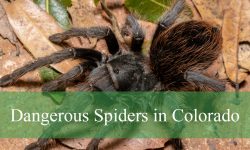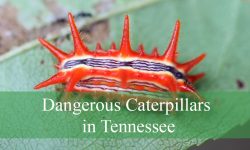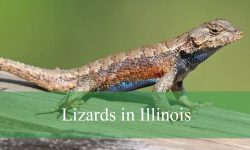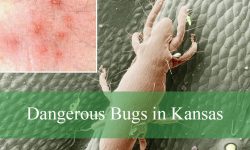Many different bugs and arthropods live in Iowa, and some can pose significant risks to people. From venomous spiders and stinging ants to venomous caterpillars and ticks, encounters with these bugs can result in painful bites or stings, allergic reactions, or, in rare cases, more serious health issues.
Most of these dangerous bugs are not aggressive unless provoked, but accidental contact is common, particularly in gardens, wooded areas, and around homes. Learning to identify them and understanding their habits is key to preventing injuries.
This guide highlights 19 of the most dangerous bugs in Iowa. Each entry includes identifying features, habitat information, and the type of danger they present, helping you recognize and avoid potential threats.
Types of Dangerous Bugs Found in Iowa
Kissing Bug (Triatoma spp.)
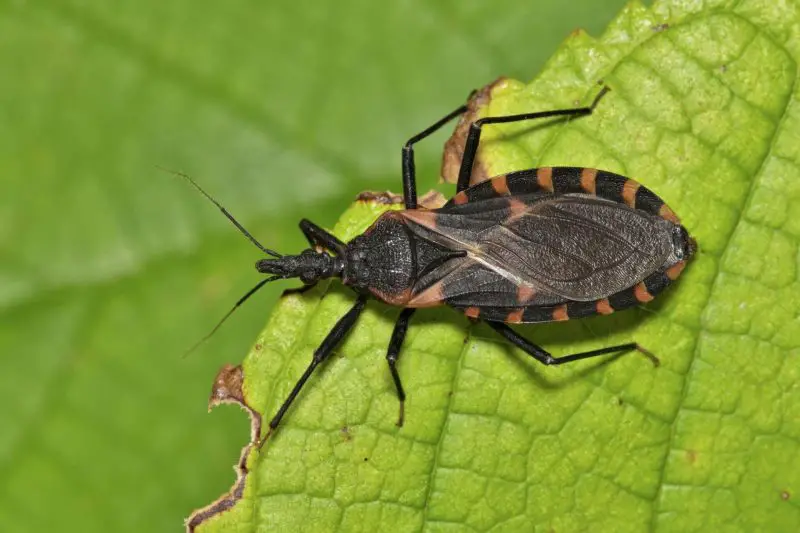
Kissing bugs are blood-feeding insects known for their potential to transmit Chagas disease, which can cause serious heart and intestinal problems in humans. They are primarily nocturnal, emerging at night to feed on mammals, including humans.
These insects are elongated, with a flat, shield-like body measuring 1 to 2 inches (2.5–5 cm) in length. Their coloration is typically dark brown or black, often with distinctive orange or red markings along the edges of their bodies and wings.
Kissing bugs are stealthy and usually hide in cracks, crevices, under beds, and inside wooden structures during the day. They are attracted to lights at night but generally avoid direct contact with humans unless feeding.
When biting, they pierce the skin to access blood, often near the lips or face—hence the name “kissing bug.” The bite is usually painless, but the insects may defecate near the bite site, and their feces can contain the parasite Trypanosoma cruzi, which can enter the body if scratched into the skin.
In Iowa, kissing bugs are primarily found in rural and suburban areas where outdoor pets or wildlife are present. Human infections are rare but possible, making them a hidden health concern. Preventive measures include sealing cracks in homes, elevating bedding, and reducing outdoor lighting that may attract these insects.
Mosquito (Aedes aegypti, Culex pipiens)
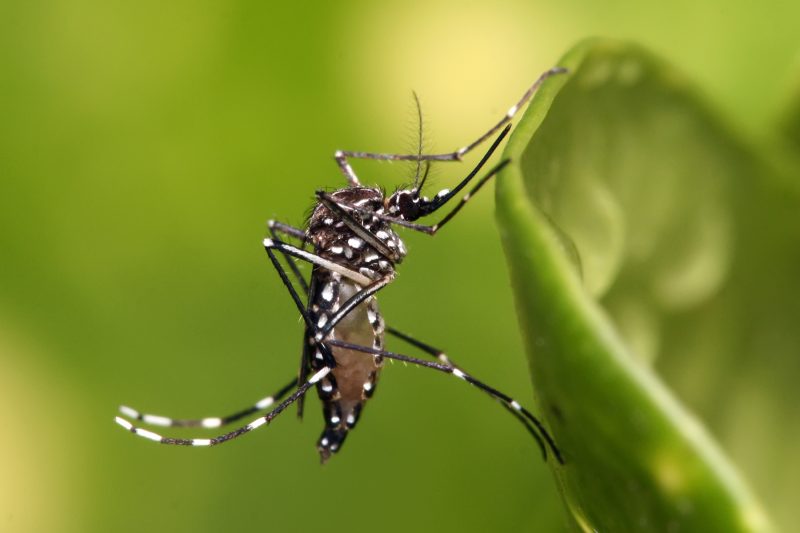
Mosquitoes are small flying insects notorious for transmitting several human diseases, including Zika, dengue fever, and chikungunya. They are most active during dawn and dusk, feeding on exposed skin for blood meals.
Aedes aegypti and Culex pipiens typically measure 3–10 mm in length and have slender bodies with long legs and delicate wings. Aedes aegypti can be identified by white markings on its legs and a lyre-shaped pattern on its thorax, while Culex pipiens has more muted brown coloring.
These mosquitoes breed in stagnant water, such as birdbaths, gutters, flower pots, or puddles near homes. Their larvae develop quickly in warm, humid conditions, which are common during Iowa summers.
Mosquito bites cause itching, redness, and swelling, and in some cases, the viruses they transmit can result in serious illness. Protective measures include wearing long clothing, using insect repellents, and eliminating standing water around homes.
In Iowa, mosquitoes are widespread, especially in urban and suburban areas with nearby water sources. While outbreaks of mosquito-borne diseases are uncommon, personal protection is crucial during the warmer months.
Blister Beetle (Epicauta spp.)
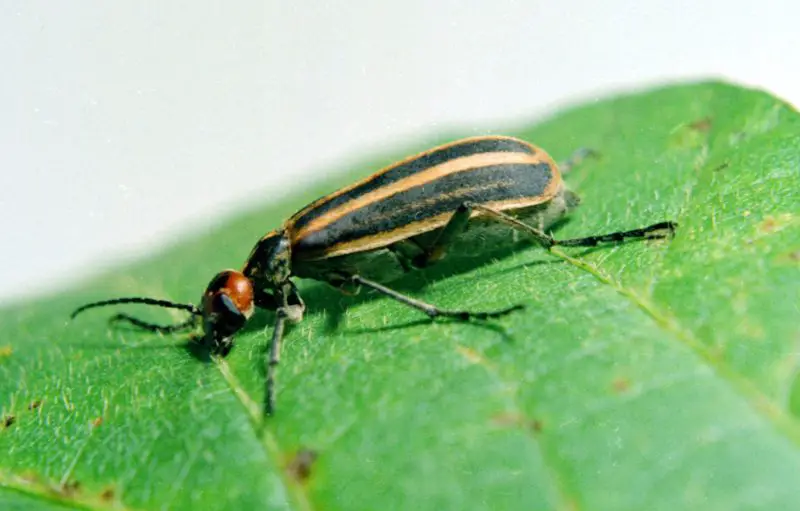
Blister beetles are elongated, soft-bodied beetles that secrete a toxic chemical called cantharidin. Contact with this substance can cause painful blisters, skin irritation, and severe reactions if ingested by humans or animals.
Adults range from 0.5 to 1.5 inches (1.3–3.8 cm) in length and typically have a slender, cylindrical body. Their coloration varies from gray to black, sometimes featuring orange, yellow, or metallic patterns.
These beetles are commonly found in fields, gardens, and areas with flowering plants, as they feed on foliage and flowers during the summer months. They are more active on warm days and often cluster on plants in groups.
Cantharidin exposure occurs through direct contact with the beetle. Skin contact usually produces localized blisters, while ingestion can lead to severe gastrointestinal issues or, in extreme cases, kidney damage.
In Iowa, blister beetles are most often encountered in pastures and cultivated fields. Livestock, particularly horses, are at risk if they consume hay contaminated with these beetles, making them a concern for both human and animal safety.
Biting Midge (Ceratopogonidae)
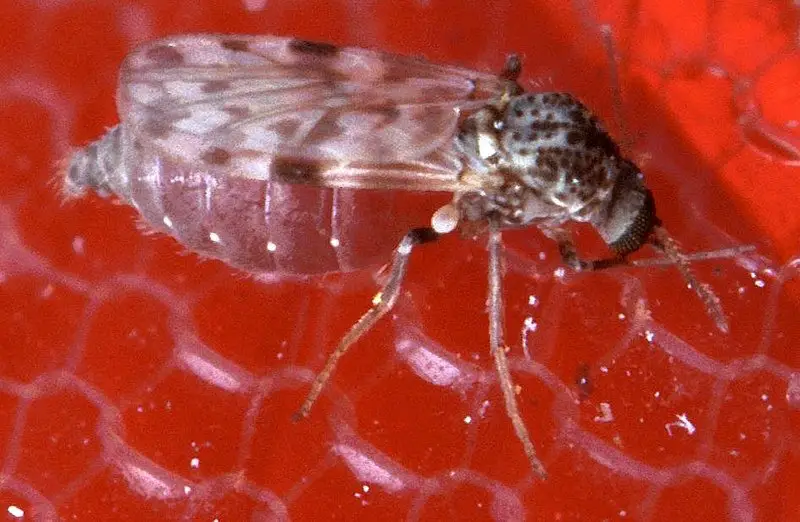
Biting midges, often called “no-see-ums,” are tiny flies, usually 1–3 mm long, that feed on the blood of mammals and birds. While their bites are extremely irritating, they rarely transmit diseases directly to humans.
These insects have slender bodies, short wings, and needle-like mouthparts designed for piercing skin. Their bites cause small, itchy red bumps, which can worsen if scratched.
Biting midges are most active during dawn and dusk and tend to swarm near wetlands, ponds, and slow-moving water, where their larvae develop. Iowa’s marshy and riparian areas provide ideal habitats for these insects.
Although midges mainly affect livestock by transmitting parasites and causing stress, humans can experience allergic reactions or secondary infections from scratching. Protective measures include using insect repellents, wearing fine mesh clothing, and avoiding infested areas.
In Iowa, biting midges are seasonal, peaking from late spring through early fall. They are more of a nuisance than a direct health threat to humans, but reducing standing water can significantly help control their populations.
Black Widow Spider (Latrodectus mactans)
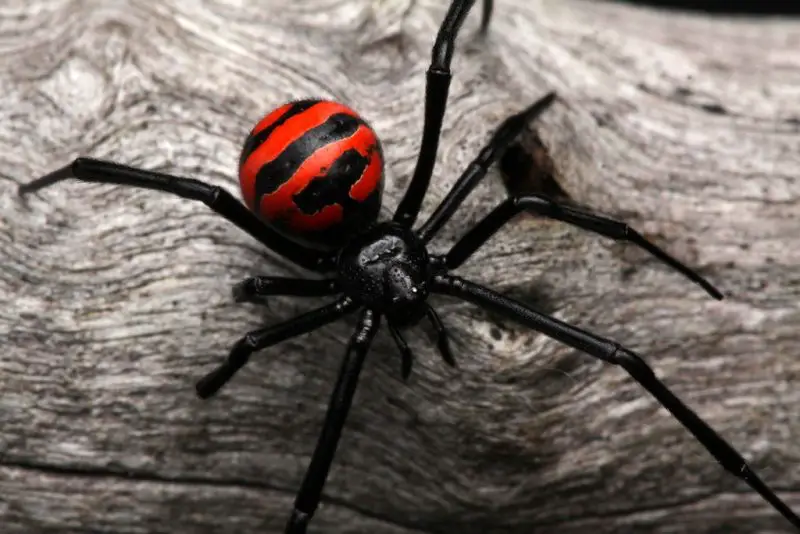
The female black widow spider is easily identified by its glossy black body and the distinctive red hourglass marking on the underside of its abdomen. They are relatively small, with body lengths ranging from 8–13 mm, but their venom is highly potent.
Black widows are shy and typically found in undisturbed locations such as woodpiles, garages, sheds, and basements. They construct irregular, sticky webs close to the ground to capture prey.
These spiders are nocturnal hunters, feeding mainly on insects. Bites are rare since black widows generally avoid humans, but accidental contact can occur when handling objects where they reside.
A bite injects neurotoxic venom, causing muscle cramps, abdominal pain, nausea, and severe localized or systemic discomfort. Medical attention is essential, especially for children, the elderly, or individuals with weakened health.
In Iowa, black widows thrive in rural and suburban areas with appropriate shelter. Awareness and careful handling of potential hiding spots are crucial to preventing bites.
Brown Recluse Spider (Loxosceles reclusa)
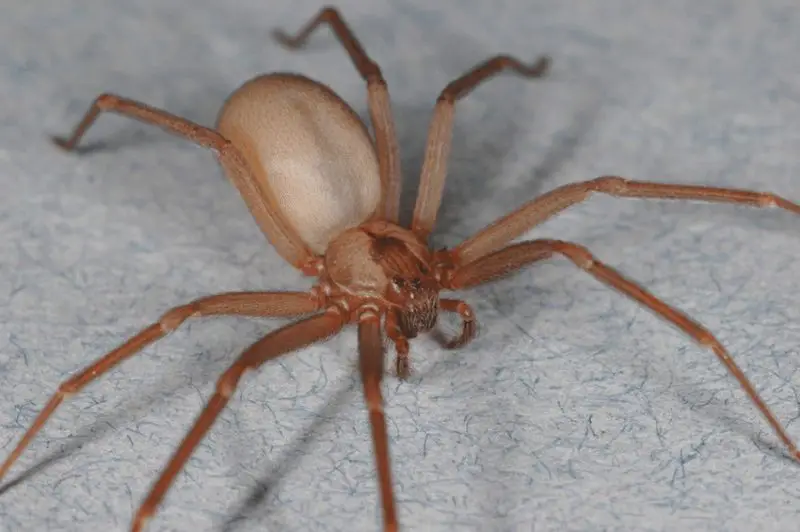
The brown recluse is a medium-sized spider, measuring about 6–20 mm in length, with a light to dark brown body and a characteristic violin-shaped mark on its back. Its long legs are usually uniform in color, lacking stripes or spines.
Brown recluses favor dark, secluded areas such as closets, attics, basements, and under furniture. They are naturally reclusive and tend to avoid human activity during the day.
These spiders are primarily nocturnal hunters, preying on insects. Bites typically occur when the spider is accidentally pressed against the skin, often during cleaning or moving objects.
Brown recluse venom is cytotoxic and can cause tissue necrosis, leading to slowly healing open sores. Immediate medical attention is essential to prevent severe tissue damage or secondary infections.
In Iowa, brown recluses are commonly found in both indoor and outdoor dry, sheltered areas. Proper storage, decluttering, and caution when moving items can reduce the risk of accidental encounters.
Sand Fly (Phlebotominae)
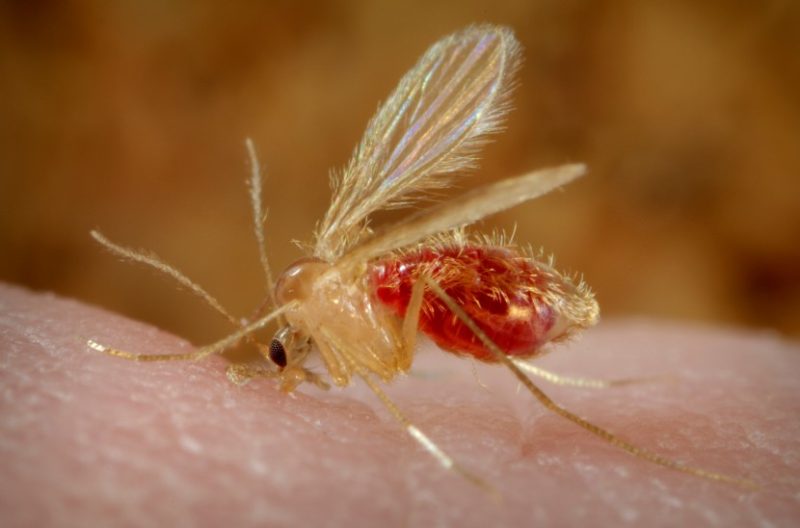
Sand flies are tiny, delicate insects, generally 2–3 mm long, with hairy wings and slender bodies. They are nocturnal blood feeders, primarily targeting mammals and occasionally humans.
These insects inhabit sandy soils, riverbanks, and moist areas, resting in cracks, burrows, and under vegetation during the day. They thrive in warm, humid climates and are more common in rural and suburban areas.
Sand fly bites can cause red, itchy bumps, and in some cases, they can transmit leishmaniasis, a parasitic disease that may lead to skin ulcers and organ damage.
In Iowa, sand flies are relatively uncommon but can appear in areas with sandy or moist soils. They are mostly a concern for travelers or people near natural habitats suitable for their lifecycle.
Protective measures include using insect repellents, wearing protective clothing, and avoiding outdoor activity during peak evening hours when sand flies are most active.
Saddleback Caterpillar (Acharia stimulea)
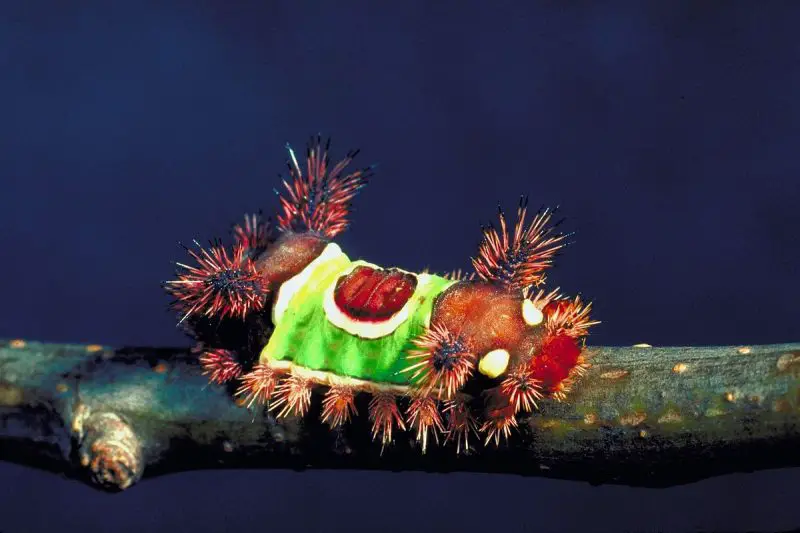
The Saddleback Caterpillar is a striking insect with a bright green body and a distinctive brown “saddle” patch bordered by white across its back. Its vivid coloration warns potential predators of its venomous nature. Fine spines cover its body, concealing venom glands.
Adults grow up to approximately 1 inch (25 mm) long, making them small but highly visible due to their bright colors. They move slowly across leaves and branches, relying on camouflage and warning coloration to deter threats. Contact with their spines releases venom.
Saddleback Caterpillars feed on the foliage of deciduous trees, shrubs, and ornamental plants. They are solitary and often found on the underside of leaves, which increases the chance of accidental contact by gardeners or children.
Contact with the spines causes immediate pain, burning, swelling, and redness at the affected site. Severe reactions can include nausea, headache, or widespread rashes in sensitive individuals.
In Iowa, Saddleback Caterpillars are commonly found in gardens, forests, and landscaped areas. Cold compresses, washing the area thoroughly, and using over-the-counter pain relief can help reduce symptoms after contact.
Stinging Rose Caterpillar (Parasa indetermina)
The Stinging Rose Caterpillar is notable for its vibrant, multicolored appearance, often displaying shades of green, orange, and white along its body. Its dorsal surface is lined with clusters of venomous spines that deliver painful stings when touched.
Adults measure about 1–1.2 inches (25–30 mm) long. Their bright coloration and spiny appearance make them easily recognizable. Like other venomous caterpillars, they are slow-moving and rely on their warning colors and spines for defense.
These caterpillars primarily feed on roses, fruit trees, and other ornamental plants. They are common in gardens and wooded areas in Iowa, where leaves provide both food and shelter. Accidental contact is the main cause of envenomation.
Stings cause sharp pain, redness, swelling, and itching at the contact site. Some individuals may experience more severe systemic reactions, including nausea or dizziness.
In Iowa, protective measures include immediately washing the affected area, applying a cold compress, and using over-the-counter pain relief to reduce discomfort. Awareness in gardens and wooded areas can help prevent accidental contact.
Puss Caterpillar (Megalopyge crispata)
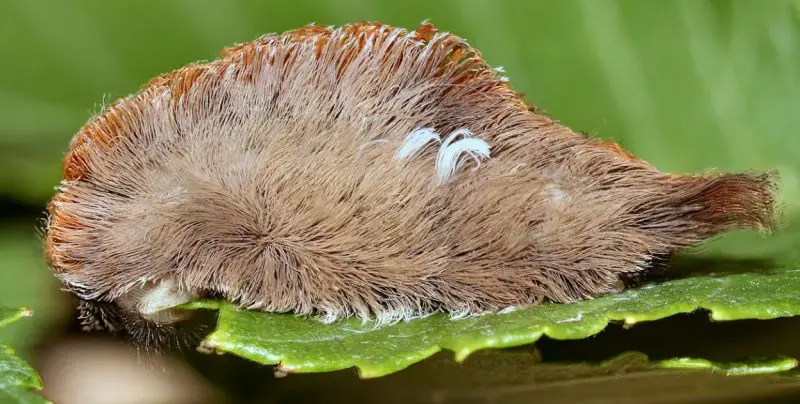
The Puss Caterpillar is covered in dense, soft, fur-like hairs that make it appear harmless and fluffy. Beneath these hairs are venomous spines capable of delivering a painful sting. The body coloration ranges from gray to brown, helping it blend with tree bark.
Adults typically grow 1–1.5 inches (25–38 mm) in length. They are slow-moving and often found resting on leaves, branches, or tree trunks. Their small size and soft appearance make accidental human contact common.
Puss Caterpillars feed on hardwood trees such as oak, elm, and other ornamental plants. They are solitary insects, and their spines serve as a primary defense mechanism against predators and curious humans.
Stings from the Puss Caterpillar cause immediate, intense pain, swelling, redness, and sometimes nausea or headache. The venom may produce lasting irritation, and small puncture marks appear where spines penetrate the skin.
In Iowa, Puss Caterpillars are commonly found in forests, gardens, and landscaped areas. Medical attention is advised for severe reactions or if stung multiple times, and awareness when handling plants or walking near trees can help prevent contact.
Velvet Ant (Mutillidae)
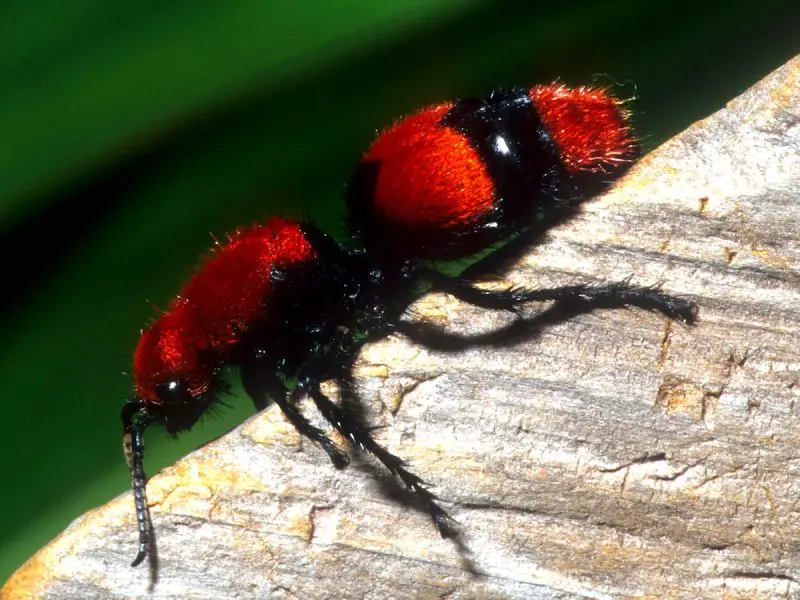
Velvet ants, often called “cow killers,” are actually wingless female wasps with dense, brightly colored hair, usually red, orange, or yellow, covering their black body. They range in size from 8–25 mm, depending on the species.
These insects are solitary and ground-dwelling. Females search for the nests of ground-nesting bees and wasps to lay their eggs. Males have wings and can fly but do not sting. Velvet ants are recognized by their striking colors and a velvety texture that gives them their name.
Velvet ants are mostly active during the day, moving quickly across sandy or dry soil. They are commonly found in open fields, prairies, and areas with loose soil where host nests are present.
The sting of a female velvet ant is extremely painful and can cause intense localized pain, swelling, and redness. While not typically fatal, the sting can induce systemic reactions in sensitive individuals and should be treated cautiously.
In Iowa, velvet ants are commonly encountered in open, dry habitats such as grasslands, prairies, and disturbed areas. Avoid handling them, and educate children about their warning coloration, which serves as a natural deterrent.
Red Imported Fire Ant (Solenopsis invicta)
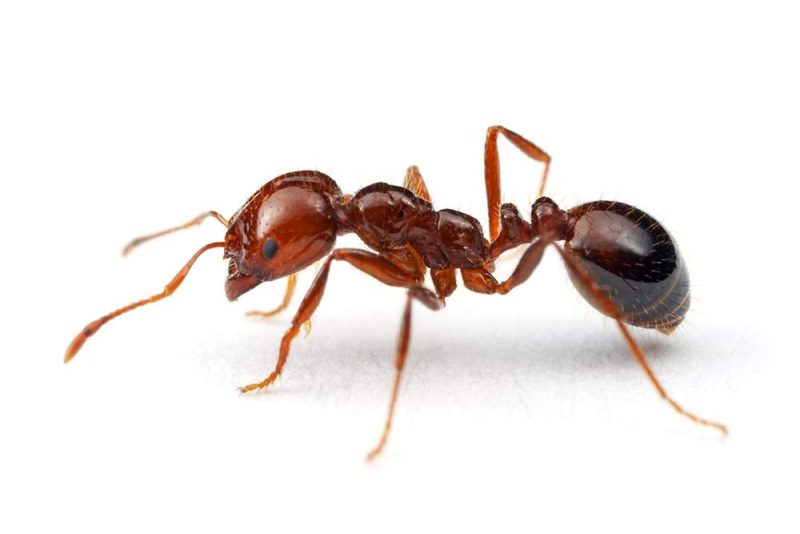
Red imported fire ants are small but aggressive ants, typically 2–6 mm in length, with reddish-brown bodies and darker abdomens. They are known for their painful stings and territorial behavior.
These ants build large, dome-shaped mounds in open, sunny areas such as lawns, pastures, parks, and roadside soil. Colonies can contain thousands of workers that defend their nest aggressively.
Fire ants sting repeatedly when disturbed, injecting venom that causes intense burning, redness, swelling, and pustule formation. Multiple stings can occur rapidly if a mound is disturbed.
Venom may trigger severe allergic reactions or even anaphylaxis in sensitive individuals. Children and pets are especially at risk due to their smaller size and closer contact with the ground.
In Iowa, red imported fire ants are widespread, thriving in urban, suburban, and rural environments. Preventive measures include avoiding mounds, wearing protective footwear outdoors, and controlling colonies using professional extermination methods.
Yellow Jackets (Vespula spp.)
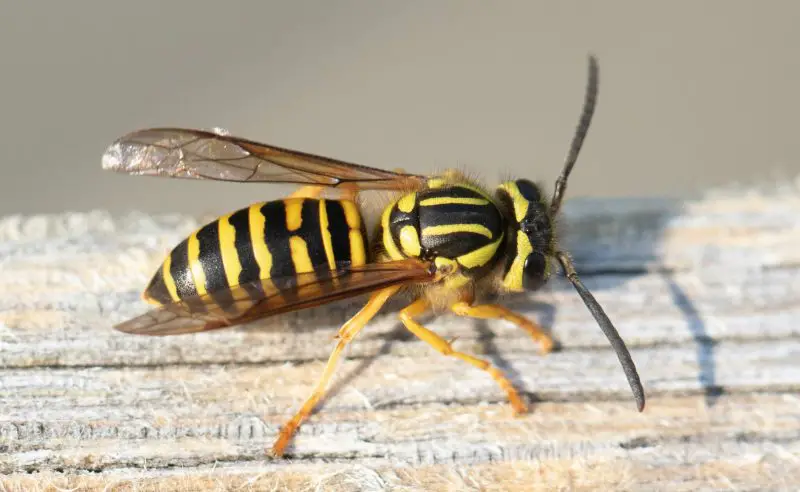
Yellow jackets are medium-sized social wasps, usually 10–16 mm long, with bright yellow and black striped bodies. They are easily identifiable by their distinctive color patterns and smooth, shiny exoskeleton.
These wasps build paper-like nests in soil cavities, wall voids, or tree hollows. Colonies can contain thousands of workers that defend their nests vigorously.
Yellow jackets are aggressive, especially in late summer when food is scarce. They sting repeatedly, injecting venom that causes immediate sharp pain, swelling, and redness.
Stings can be dangerous for allergic individuals, potentially leading to systemic reactions or anaphylaxis. Their aggressive behavior around food and drinks makes them a common hazard at outdoor gatherings.
In Iowa, yellow jackets are prevalent throughout the warmer months. Avoid provoking nests, keep food covered outdoors, and wear protective clothing when working near nests to minimize the risk of stings.
Paper Wasp (Polistes spp.)
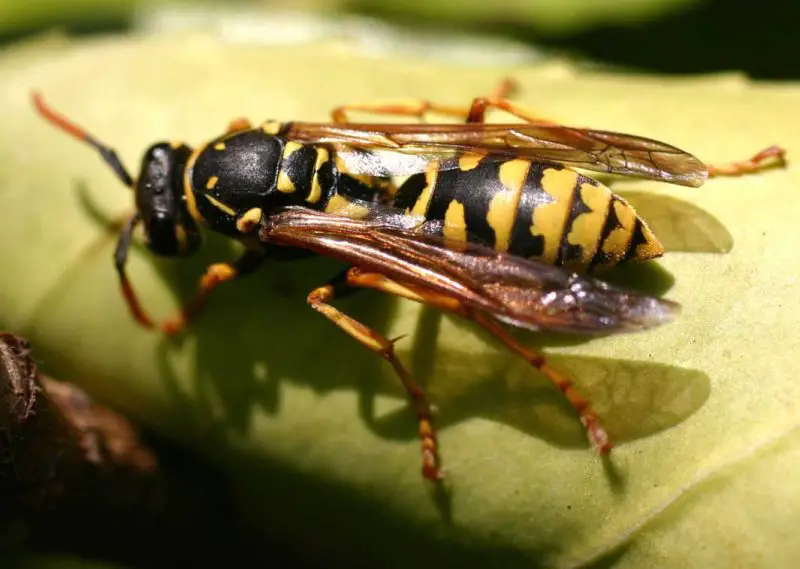
Paper wasps are slender, elongated wasps, typically 15–25 mm long, with brown, reddish, or black bodies often marked with yellow patterns. They are less aggressive than yellow jackets but can sting repeatedly if threatened.
These wasps build small, open, umbrella-shaped nests made of paper-like material under eaves, branches, or in sheltered structures. Nests usually contain a few dozen workers and are easily visible.
Paper wasps are diurnal hunters, feeding on nectar and preying on caterpillars and other soft-bodied insects to feed their larvae. They play an important role in controlling garden pests.
Stings inject venom that causes sharp pain, redness, and swelling. Reactions are usually mild but can be severe in allergic individuals, necessitating prompt medical attention.
In Iowa, paper wasps are commonly found in suburban and rural areas. Avoid disturbing their nests, especially during the summer months, and wear protective clothing when working near them.
Wheel Bug (Arilus cristatus)
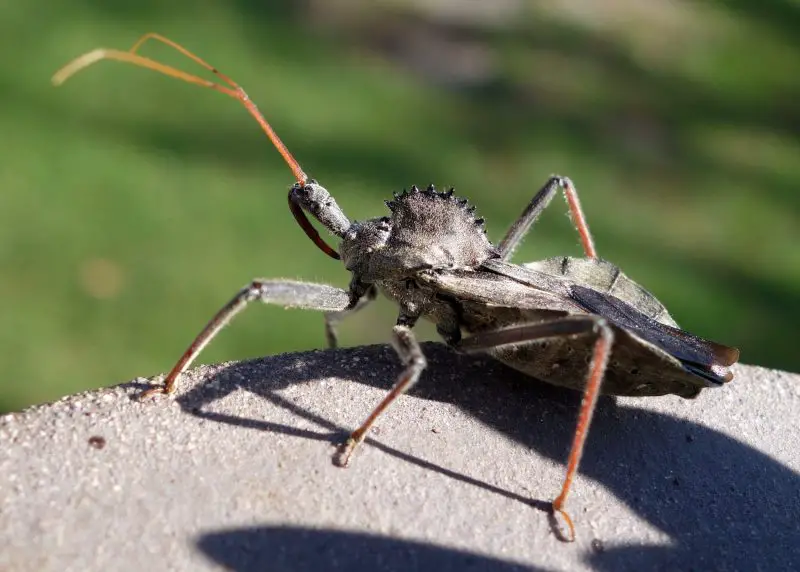
The wheel bug is a large predatory true bug, measuring 25–45 mm in length, easily recognized by the cogwheel-like structure on its thorax. Its body is gray or brown, camouflaging well with tree bark and foliage.
Wheel bugs are solitary predators, feeding on caterpillars, beetles, and other insects by injecting digestive enzymes with their piercing-sucking mouthparts. They play an important role in controlling garden pests.
These bugs are primarily active during the day and are slow-moving, often spotted on trees, shrubs, and outdoor furniture. They are not aggressive unless handled.
Bites are rare but can occur if the bug is provoked. The bite delivers enzymes that cause intense, sharp pain, swelling, and localized redness, sometimes lasting several hours.
In Iowa, wheel bugs are widespread in gardens, orchards, and wooded areas. Admire them from a distance and avoid handling to prevent painful bites.
Cicada Killer Wasp (Sphecius speciosus)
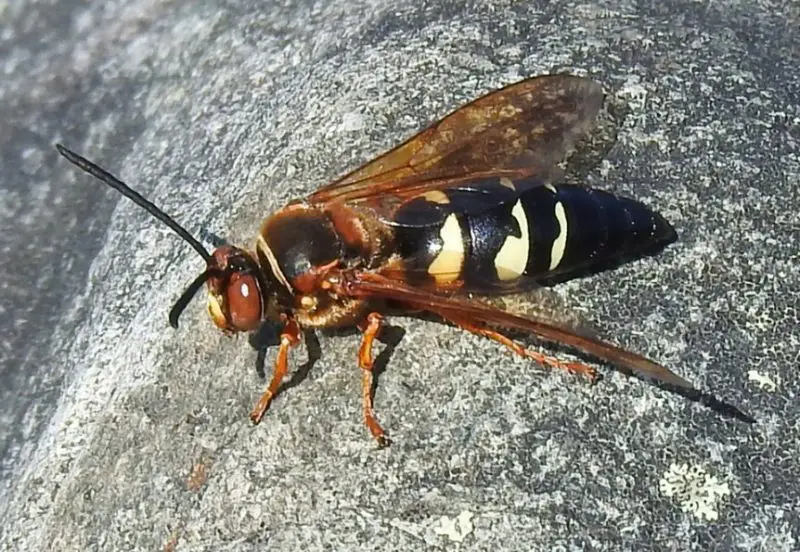
Cicada killer wasps are large, robust wasps, 32–55 mm in length, with reddish-brown bodies, yellow markings, and long legs. Females are wingless when digging burrows but fly to hunt cicadas.
These solitary wasps dig deep burrows in sandy or loose soil to lay eggs. Each female paralyzes several cicadas to provision her burrow, which serves as food for her developing larvae.
Cicada killer wasps are active during warm months, primarily in the afternoon. Males are territorial but cannot sting, while females can sting if directly threatened.
Stings are painful but rarely dangerous unless the individual is allergic. Symptoms include sharp pain, redness, and minor swelling at the sting site.
In Iowa, cicada killer wasps are most commonly found in open fields, gardens, and lawns with sandy or well-drained soil. Avoid disturbing burrows and do not attempt to handle the wasps directly.
Ticks (e.g., Lone Star Tick, Dermacentor variabilis)
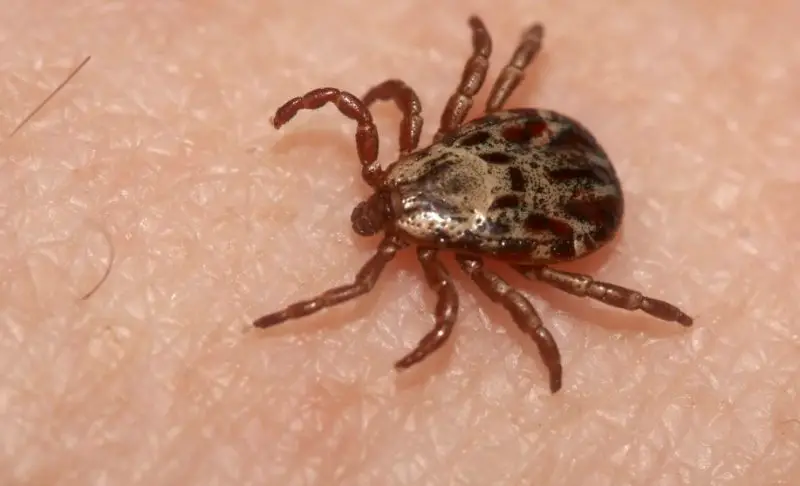
Ticks are small, blood-feeding arachnids ranging from 3–5 mm unfed to over 10 mm when engorged. Lone Star ticks are recognizable by a distinctive white spot on the female’s back, while Dermacentor variabilis (American dog tick) has ornate scutum patterns.
These arthropods are parasitic, feeding on the blood of mammals, birds, and occasionally humans. They attach firmly using specialized mouthparts and can remain attached for several days.
Ticks inhabit tall grass, shrubs, wooded areas, and the edges of trails. In Iowa, they are common in rural and suburban environments where wildlife or domestic animals are present.
Bites can transmit serious diseases such as Lyme disease, Rocky Mountain spotted fever, and tularemia. Symptoms may include fever, rash, fatigue, and muscle aches. Prompt removal of ticks and medical attention are essential.
Preventive measures include wearing long sleeves and pants, using repellents with DEET or permethrin, checking for ticks after outdoor activity, and keeping lawns and trails clear of tall vegetation.
Scorpion (Centruroides vittatus)
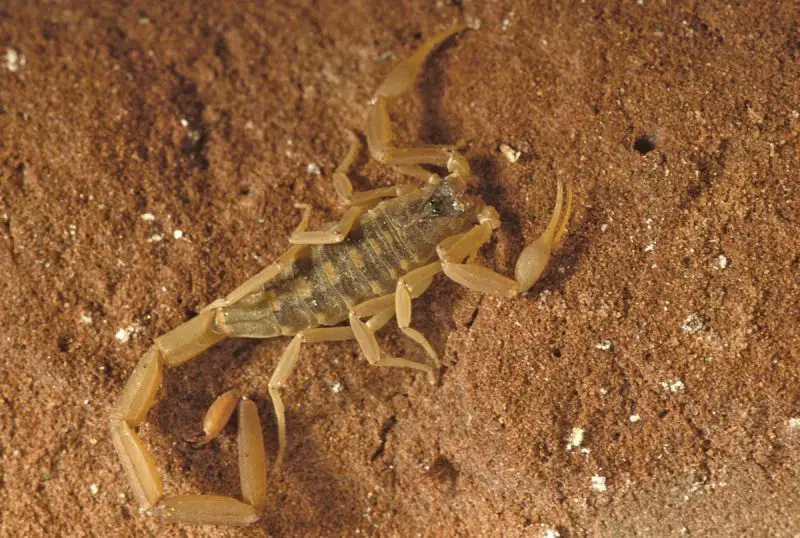
The striped bark scorpion is a medium-sized arachnid, 2–4 cm long, with a yellowish-brown body and darker stripes along its back. Its tail ends with a venomous stinger capable of injecting toxins.
Scorpions are nocturnal hunters, feeding on insects and small arthropods. They hide during the day under rocks, wood, or debris and occasionally enter homes.
In Iowa, scorpions are relatively rare but can appear in warm, dry areas, including gardens, yards, and wooded edges. Human encounters are uncommon but possible during outdoor activities.
Stings cause intense pain, swelling, and numbness at the site. Systemic reactions, such as muscle twitching, difficulty breathing, or severe allergic responses, are rare but require medical attention.
Preventive strategies include checking shoes and clothing before wearing, sealing gaps in buildings, and using caution when working outdoors, especially at night.
Oak Leaf Itch Mite (Pyemotes herfsi)
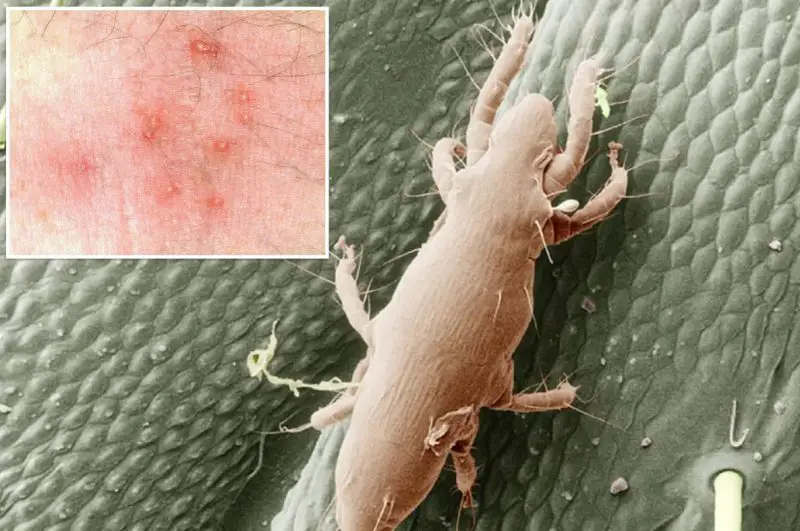
Oak leaf itch mites are microscopic arachnids, less than 0.5 mm long, often invisible to the naked eye. They parasitize insects that live in oak leaves but can bite humans accidentally.
These mites reside on oak trees, particularly in leaves, bark, or galls, becoming active during warm months. They are most prevalent in areas with dense oak populations.
Bites produce intense itching, red welts, and sometimes rashes. Reactions are usually localized but can be uncomfortable and lead to scratching-induced secondary infections.
In Iowa, oak leaf itch mites are common in forests, parks, and residential areas with oak trees. They pose minimal health risk but can be a nuisance during outdoor work or recreation.
Preventive measures include wearing long sleeves and gloves, avoiding direct contact with infested foliage, and washing exposed skin promptly after outdoor activity.
FAQs About Dangerous Bugs and Arachnids in Iowa
What bugs in Iowa can transmit diseases to humans?
Several bugs and arachnids in Iowa are vectors for diseases. Mosquitoes (Aedes aegypti, Culex pipiens) can transmit Zika, dengue, and chikungunya. Kissing bugs may carry Chagas disease. Ticks such as the Lone Star Tick and American dog tick can transmit Lyme disease, Rocky Mountain spotted fever, and tularemia. Sand flies can potentially transmit leishmaniasis.
Which spiders in Iowa are dangerous to humans?
The two primary dangerous spiders in Iowa are the Black Widow Spider (Latrodectus mactans) and the Brown Recluse Spider (Loxosceles reclusa). Black widows have potent neurotoxic venom, causing muscle cramps and severe pain. Brown recluses have cytotoxic venom, which can lead to tissue necrosis if untreated.
What should I do if stung by a fire ant or wasp?
If stung by Red Imported Fire Ants, Yellow Jackets, Paper Wasps, or Cicada Killer Wasps, immediately clean the area with soap and water. Apply a cold compress to reduce swelling. Over-the-counter pain relievers or antihistamines can help manage discomfort. Seek medical attention if there are signs of a severe allergic reaction, such as difficulty breathing, dizziness, or widespread hives.
Are velvet ants dangerous?
Yes, female velvet ants can deliver extremely painful stings. While not typically life-threatening, the sting can cause intense localized pain, swelling, and redness. People who are allergic to insect venom should exercise caution. Males do not sting and are harmless.
How can I prevent bites and stings from dangerous bugs and arachnids?
-
Wear long sleeves, pants, and closed shoes when outdoors, especially in tall grass, wooded areas, or open fields.
-
Use insect repellents containing DEET or permethrin.
-
Avoid handling unknown bugs, spiders, or scorpions.
-
Inspect shoes, clothing, and bedding for hidden bugs like scorpions or velvet ants.
-
Remove standing water and maintain yards to reduce mosquito and midge habitats.
-
Seal cracks and gaps in homes to prevent entry by spiders, scorpions, or kissing bugs.
What are common symptoms of bites or stings in Iowa?
Symptoms vary depending on the species:
-
Pain, redness, swelling, and itching are common for most bites and stings.
-
Blisters or rashes may occur from blister beetles or oak leaf itch mites.
-
Severe systemic reactions, such as nausea, muscle cramps, or difficulty breathing, may result from black widow, fire ant, or scorpion stings.
-
Immediate medical attention is recommended for bites from venomous spiders, scorpions, or allergic reactions to stings.
When are these dangerous bugs and arachnids most active?
-
Nocturnal: Kissing bugs, scorpions, black widows, brown recluses, sand flies.
-
Diurnal / Daytime: Velvet ants, wheel bugs, cicada killer wasps, paper wasps, fire ants.
-
Dawn/Dusk: Mosquitoes and biting midges.

